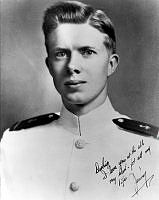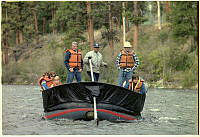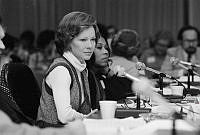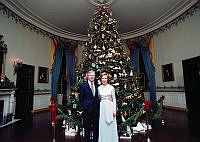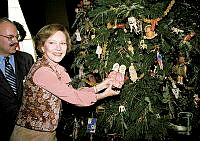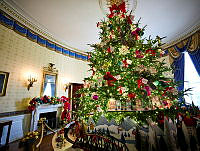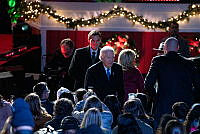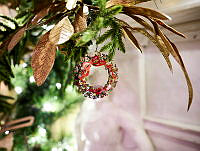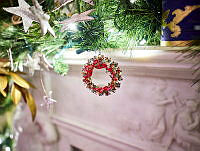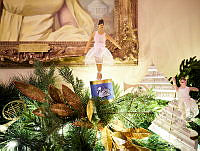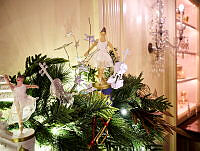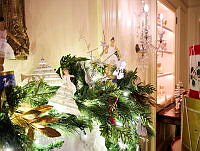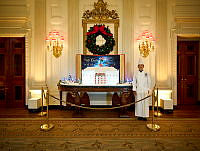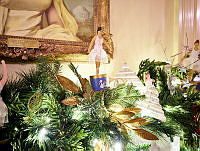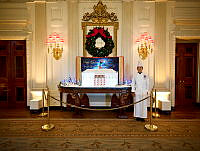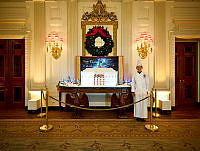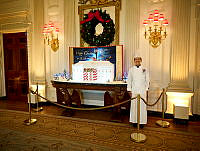Mamie Eisenhower

Mamie Geneva Doud was born on November 14, 1896, in Boone, Iowa. She was the daughter of John Sheldon Doud and Elivera Mathilda Carlson Doud. The Doud family later moved to Colorado, eventually settling in Denver. Mamie attended local public schools and graduated from the Wolcott School, a private school for girls in 1915. That fall she met Second Lieutenant Dwight D. Eisenhower, and on February 14, 1916, the couple announced their engagement. They were married on July 1, 1916, at the Doud family home.1
The Eisenhowers had two sons—Doud Dwight Eisenhower and John Sheldon Doud Eisenhower. Doud, also called “Little Icky,” passed away in 1921 after contracting scarlet fever. John was born the following year, and for the next two decades the Eisenhowers lived throughout the United States and around the world. These experiences as a military spouse shaped Mamie’s sense of duty, frugality, and hospitality, as well as affirmed her support for her husband’s career and devotion to her family. These priorities remained at the forefront for her entire life, including her time as first lady.
During World War II, Dwight Eisenhower was elevated to General of the United States Army and Supreme Commander of the Allied Expeditionary Forces. Mamie took up residence at the Wardman Park Hotel in Washington, D.C., where she lived for most of the war. She volunteered for the American Red Cross and was present when her son John graduated from Dwight’s alma mater, the United States Military Academy at West Point, on June 6, 1944.2
In 1948, the Eisenhowers moved to New York City when Dwight became the president of Columbia University. He later left to serve as Supreme Allied Commander in Europe and head of NATO military forces. As a result, Dwight and Mamie lived in Paris, France, until they returned to the United States when Eisenhower campaigned as the Republican nominee and handily won the 1952 presidential election.
As first lady, Mamie Eisenhower festively decorated the White House for holidays such as Christmas and Halloween. In 1953, she and the president brought back the White House Easter Egg Roll, which had been suspended since 1942. The Executive Mansion also served as the backdrop for many memorable family moments with their grandchildren—Dwight David, Barbara Anne, Susan Elaine, and Mary Jean. The president and first lady hosted birthday parties, holiday meals, and family events, including Mary Jean’s Blue Room christening in April 1956.3 The role of first lady did not change Mamie’s familial obligations. She later said, “I was Ike’s wife, John’s mother, the children’s grandmother…[and] that was all I ever wanted to be.”4
Mamie’s love of pink—in her accessories, clothing, and décor—was well known. She not only refreshed the master bedroom with “Mamie pink” but also used splashes of the color at Camp David and the Eisenhower property at Gettysburg, Pennsylvania. Women imitated her famous short bangs, and her popularity surged with the American public.
Mamie generally avoided politics and publicity, focusing more on the White House and events, as well as managing the residence staff. She met with the chief usher nearly every morning to discuss the day’s schedule and visitors. She spent most of her time planning and attending social events, responding to correspondence, answering requests, and greeting guests.5 “As the wife of a career army officer, she understood the hierarchy of a large establishment, the division of responsibilities, and how to direct a staff,” recalled White House Chief Usher J.B. West.6
During the Eisenhower presidency, there were several significant donations made to the White House. One of Mamie’s friends, Margaret Thompson Biddle, gifted a collection of 1,575 pieces of vermeil (gilded silver). This later became the basis for the Vermeil Room on the Ground Floor. The Eisenhowers also accepted an assortment of early nineteenth-century American furnishings for the Diplomatic Reception Room. This was the first time an entire room was furnished with high-quality American antiques and set a precedent for future occupants.7
After leaving the White House, the Eisenhowers retired to Gettysburg. When Dwight passed away in 1969, Mamie continued living at the property and was a frequent guest at the Nixon White House. On November 1, 1979, Mamie Eisenhower passed away in Washington, D.C. She was buried next to her husband and Doud in the Place of Meditation at the Dwight D. Eisenhower Presidential Library and Museum in Abilene, Kansas.8
Footnotes & Resources
- https://www.eisenhowerlibrary....
- Mamie Doud Eisenhower, 1896-1979, https://catalog.archives.gov/i...
- “White House Christening,” The Daily News, April 24, 1956.
- “Mamie Grants a Rare Interview at Gettysburg; She Misses Ike,” The Philadelphia Inquirer, July 22, 1974.
- “Mrs. Eisenhower Takes Capital Without Struggle,” The Courier-News, May 26, 1953.
- J.B. West, Upstairs at the White House: My Life with the First Ladies, with Mary Lynn Kotz (New York: Coward, McCann & Geoghegan, Inc., 1973), 130-131.
- Betty Monkman, The White House: Its Historic Furnishings & First Families (Washington, D.C.: White House Historical Association, 2014), 225-226.
- https://www.eisenhowerlibrary....















